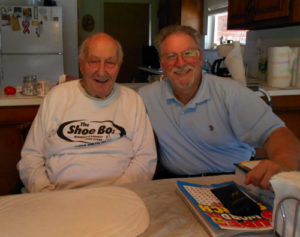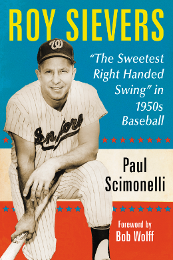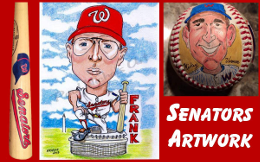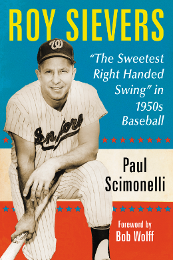Roy Sievers baseball life is the stuff of Hollywood movies.
St. Louis native Roy Sievers was literally born into a baseball life. Roy’s dad, Walter  Sievers, had a successful tryout with the Detroit Tigers in 1916, and was offered a minor league contract. He wanted to be a pitcher, but with his lethal bat, the Tigers wanted him in the outfield to play every day. They offered him $50 a month, but Walter’s father William said no, he needed to make his money in St. Louis to aid his family. Walter instilled his love for baseball into his young son Roy.
Sievers, had a successful tryout with the Detroit Tigers in 1916, and was offered a minor league contract. He wanted to be a pitcher, but with his lethal bat, the Tigers wanted him in the outfield to play every day. They offered him $50 a month, but Walter’s father William said no, he needed to make his money in St. Louis to aid his family. Walter instilled his love for baseball into his young son Roy.
An outstanding three sport athlete at St. Louis’s famed Beaumont High School, Roy was signed by the St. Louis Browns in 1945. After a two year hitch in the Army and two years in the minors, Roy was brought up to the parent club in 1949, where he astounded everyone with his career-best .306 batting average, 16 home runs (which led all rookies), and 91 runs batted in (ranking sixth in the league). He was named the first American League Rookie of the Year by the Baseball Writers Association of America.
Roy slumped badly in 1950, but his managers remained faithful he would come out of it.
In ‘51, Roy continued to slump, and was sent down to San Antonio for “seasoning.” There he suffered a terrible shoulder dislocation on August 1st which ended his season. In ‘52, Roy tried to come back in spring training, only to dislocate his shoulder again, and was out for the year. Bill Veeck, then owner of the Browns, payed for Roy to undergo a harrowing experimental surgery to repair his injured shoulder, which ultimately proved to be a success. In ‘53, Roy got into 92 games playing part time, and hit a respectable .270, with 8 HR and 35 RBI
Traded to the Washington Senators in 1954, Roy rose to his full potential. In his six years with the Senators, Roy set the franchise home run record four years in a row, averaging 30 home runs, 95 RBI and a .266 batting average in his 6 years with the Senators.
Bill Veeck, then owner of the Chicago White Sox, finally lured Sievers away from Washington in the spring of 1960. Roy returned the favor by averaging 27 home runs, 92 RBI, and a .295 batting average for his two year stint with the Chisoxs. Veeck got sick and had to sell the team in 1962. The new owners, wanting speed over power, traded Roy to the Philadelphia Phillies, where he was platooned at 1st base by manager Gene Mauch. Roy played respectfully, but was traded to the expansion Senators after suffering another debilitating injury in 1964. Roy ended his career pinch hitting for manager Gill Hodges in 1965.
For his career, Roy blasted 316 home runs, had 1147 RBI, and a .267 batting average. At the time Roy hit his 300th home run, he was only the 16th man in baseball history to reach that plateau.
Yet, despite Roy’s tremendous career statistics, his mammoth home runs, timely hits and great run production, he has been overlooked for numerous honors.
Why?
Bill James, noted baseball historian and statistician, in The New Bill James Historical Baseball Abstract, describes Washington Senators slugger Roy Sievers thusly:
“Can you name another player who had a value pattern as Roy Sievers? I’m not sure there is one. Sievers was a standout rookie in 1949 (for the St. Louis Browns), hitting 306 with 91 RBI, and winning the American League Rookie of the Year award. After that, however, he drifted into a prolonged slump, lost his regular status, had two serious injuries, drifted completely out of the Major Leagues, and had to go back to the minors and re-establish himself. He didn’t re-emerge as a regular until five years later, 1954, but then became a star, driving in almost 100 runs a year for a decade.”
James has also established what he calls his “underrating system” to explain why so many players are overlooked when it’s time to hand out accolades. I have bracketed those categories into where Roy fits:
- Specialists and players who do two or three thigs well are overrated; players who do several things well are underrated
- Batting average is overrated; secondary offensive skills, summarized as secondary average, are underrated
BA [.267] SecA [.339] RC/G [5.9]
- Driving in runs is overrated; scoring runs is underrated
RS [945] RBI [1147] HITS [1703]
- Players who play on Championship teams are sometimes overrated; players who get stuck on bad teams are often underrated. [Sievers]
- Players who play in NY or LA are sometimes overrated, while players on small market teams are often underrated. [Sievers]
- Players who are glib and popular with the press are sometimes overrated, while players who are quiet are sometimes underrated. [Sievers]
- Players who play in parks which do not favor their skills are always underrated; Players who play in parks which favor them-hitters in Colorado, lefties in Yankee Stadium, pitchers in the Astrodome- are always overrated. [Sievers]
- Hitters from big-hitting eras (the 1890’s, 1920’s and ‘30’s) are overrated in history and pitchers from the dead ball era and the ‘60’s are overrated. Pitchers from the big-hitting era and hitters from the ‘60’s are underrated.
- Undocumented skills (leadership, defensive skills, heads-up play) tend to be forgotten over time. Everything else deteriorates faster than the numbers. [Sievers]
- Anything which “breaks ups” a player’s career tends to cause him to be underrated: injury, switching positions, switching teams. A players who has a good career with one team will be thought of more highly than a player who does the same thing, but with three different teams. Switching positions causes players to be underrated. [Sievers]
If great character were to be a flaw, then it would be Roy Sievers shortcoming. Roy Sievers was quite literally the “nice guy” who not only finished last but started last, with both the cellar dwelling St. Louis Browns and Washington Senators. The quiet Midwesterner never uttered an unkind word about teammates, managers or umpires, never questioned a bad call, and was never, ever, thrown out of a ballgame. He was a team leader and a willing mentor to younger players. He always made time for his fans, never refused an autograph, and was beloved for it.
Noted baseball writers Shirley Povich and Bob Addie both alluded to the fact that there was never a good reason to go to a Senators ball game in the 1950’s other than to watch the play of Roy Sievers. Roy’s prodigious home run hitting was the only thing that kept the fans coming to the cavernous and dreary Griffith Stadium, increasing attendance by 45% between 1955 and 1959. During those years, Senators attendance was either 7th or 8th in the league, yet Griffith still was able to run the team in the black.
In 1956, Roy’s All Star status, along with minority owner H. Gabriel Murphy’s fierce protestations and threatened law suit, forced the parsimonious Calvin Griffith to keep the team in Washington DC, even after being courted by a consortium of interests in Los Angeles. San Francisco and Minneapolis. Perhaps Roy’s celebrity and the intersection of baseball and politics caused powerful Tennessee Senator Estes Kefauver to open Senate antitrust proceedings after hearing of Griffith’s intentions to move the team from the Federal City. After all, Roy had the “ear” of Richard Nixon, a self-avowed “Sievers fan,’” who was a frequent guest at Griffith Stadium and Sievers visited the VP Mansion on several occasions. Many a politico was entertained by Griffith during Roy’s tenure from 1956 to 1960, and they enjoyed free passes to the game or sat in the owner’s box for free. All the while, minority owner H. Gabriel Murphy’s running feud with Griffith over keeping the team in Washington escalated to suit in DC and Federal courts and, unsuccessfully, in the United States Supreme Court.
Ultimately, Major League Baseball agreed to expand both the American and National leagues in 1960, allowing Griffith to move the Senators to Minnesota, on the condition that a new team would be installed in Washington.
If Roy Sievers had not set franchise home run records from 1954 through 1957, hit an all-time franchise home run mark of 42 home runs in 1957, and increased attendance for 5 straight years, there would have been no Washington Senators team staying in D.C., no expansion Senators in 1961, no Frank Howard to overtake that mark with 48 homers in 1969, and no current Washington Nationals team in D.C. Statisticians far greater than I will point out that Roy’s lifetime numbers do not warrant enshrinement into the National Baseball Hall of Fame.
However, I contend that for the aforementioned reasons above, Roy Sievers deserves to be enshrined into the Washington Nationals Ring of Honor. The Ring of Honor was ostensibly created to honor those players and managers who are enshrined in the National Baseball Hall of Fame. With the induction of Frank Howard into the Ring, a precedent has been set to allow Roy Sievers into that vaulted company.
The current Washington Nationals have broken attendance records year after year, showing that D.C. has always been a baseball city.
In my opinion, this is because of Roy Sievers
Roy Sievers into the Nationals Ring of Honor
We, the undersigned, respectfully request that the Washington Nationals honor Roy Sievers by placing him in the Ring of Honor at Nationals Park, Washington DC.
https://www.gopetition.com/petitions/roy-sievers-into-the-nationals-ring-of-honor.html
Amazon.com: Roy Sievers: “The Sweetest Right Handed Swing” in 1950s Baseball (9781476668697): Paul Scimonelli, Foreword by Bob Wolff: Books available at Amazon and McFarland Press







